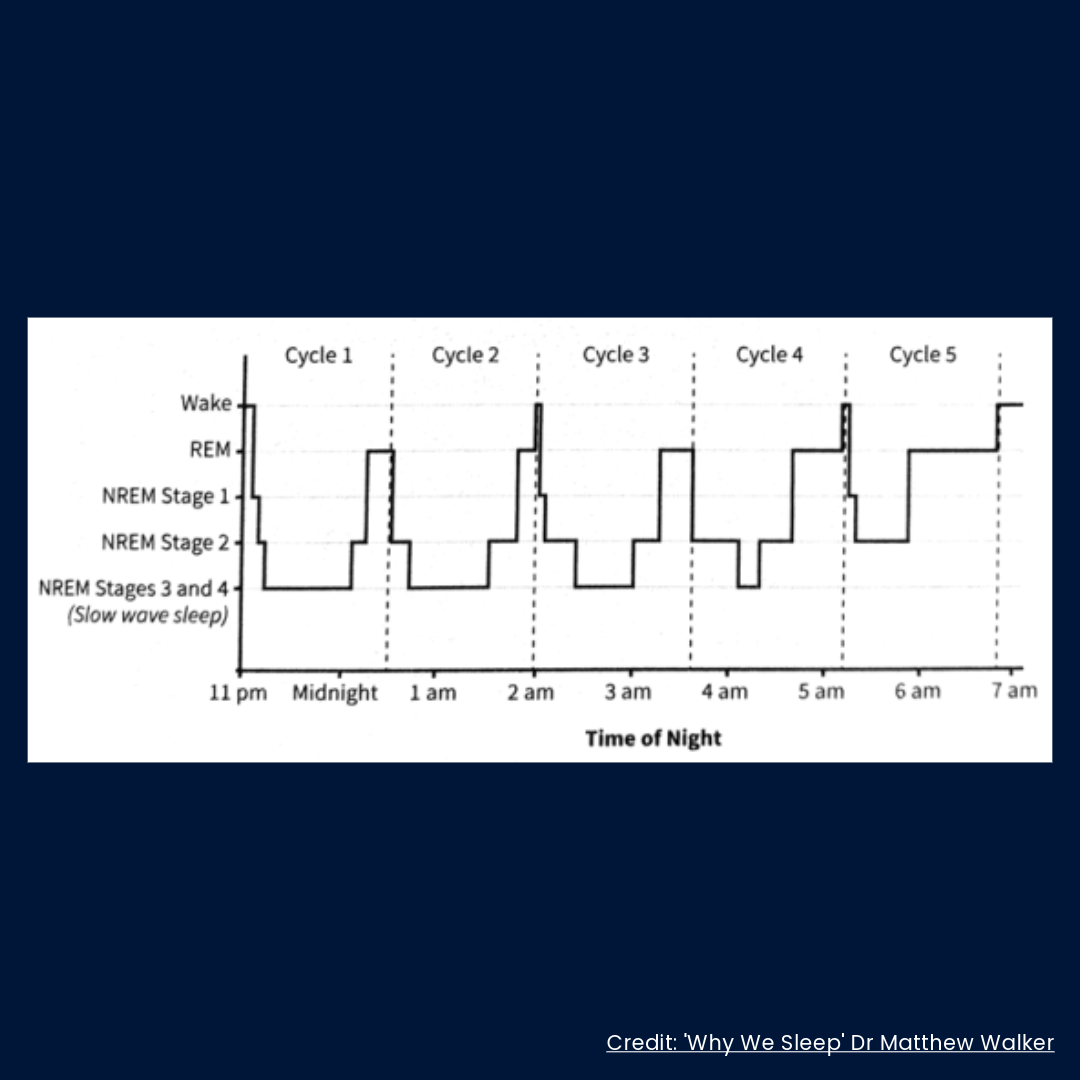You know that awkward moment when you run into someone you met yesterday, but their name is gone from your mind? You know it’s in there somewhere, but right now? Blank. It turns out, the culprit might not be a bad memory; it could be your sleep.
To understand this more, we need to look at the sleep cycle. Sleep takes up about a third of our lives. Still, most of us know very little about what happens. As we sleep, we move through different stages, each serving a unique purpose.
Let’s break it down, focusing on its two main phases: NREM (Non-Rapid Eye Movement) and REM (Rapid Eye Movement) sleep.
WHAT IS THE SLEEP CYCLE?
The sleep cycle is the pattern of NREM and REM sleep that your body repeats several times each night. A single cycle usually lasts around 90 minutes. Most people complete four to six cycles each night. NREM is more common in the early cycles, while REM increases as morning approaches.
Each phase is important for healing your body, storing memories, and managing emotions. If you miss out on either, you’ll likely feel it the next day. This might show up as physical tiredness, mental fog, or emotional ups and downs.

The stages of a typical night’s sleep. Notice how REM sleep becomes more concentrated in the later part of the night, right up until morning.
THE NREM PHASE
NREM sleep makes up about 75% of the sleep cycle. This phase is all about physical recovery and restoration.
STAGE 1: The Gateway to Sleep
Stage 1 is the lightest sleep stage. It lasts a few minutes as your body starts to disconnect from its surroundings. During this time:
- Your heart rate and breathing slow down.
- Your muscles start to relax, which can cause the well-known hypnic jerk. This is that sudden feeling of falling that often happens when you’re sleeping in public.
- Brain activity changes from wakefulness to theta waves. These waves are slower and more rhythmic.
STAGE 2: Light Sleep
This stage usually lasts 10 to 25 minutes in the first cycle. It then gets longer with each cycle that follows. During Stage 2:
- Your body temperature drops, and your muscles relax further.
- Brain activity includes sleep spindles (quick bursts of brainwaves) and K-complexes. These shield your sleep from outside interruptions.
- The body begins its repair processes, and the heart rate slows further.
STAGE 3: Deep Sleep
Also called slow-wave sleep (SWS), this is the most restorative stage of NREM sleep. It dominates the earlier part of the night and features:
- DELTA WAVES: The slowest and most synchronised brain activity.
- PHYSICAL REPAIR: Growth hormone is released. This helps to aid cell repair, muscle recovery, and immune function.
- ENERGY RESTORATION: The body refills energy stores. It also clears metabolic waste from the brain using the lymphatic system.
Deep sleep is critical for physical health. It’s what leaves you feeling refreshed and rejuvenated the next morning. Not getting enough deep sleep can lead to muscle fatigue, a weaker immune system, and trouble focusing.
THE REM PHASE
While NREM sleep is all about physical recovery, REM sleep focuses on the brain. REM sleep makes up about 20-25% of total sleep (roughly 1 hour 10 mins to 1 hour 40 mins a night). It is a fascinating phase, acting much like your brain’s own filing system.
What Happens During REM Sleep?
- BRAIN ACTIVITY: During REM sleep, brain activity resembles wakefulness. It shows rapid and desynchronised brain waves. This is why it is also called “paradoxical sleep” as your brain is highly active, but your body is deeply relaxed.
- DREAMING: Vivid dreams mostly happen during REM. This is when the brain works through emotions, experiences, and memories.
- MUSCLE PARALYSIS: Your body goes through atonia, a temporary paralysis of voluntary muscles. This helps to prevent you from acting out your dreams.
- Atonia is different from sleep paralysis. Sleep paralysis is when you can't move or speak for a short time, but you are aware of being stuck. It occurs when your brain wakes up from REM sleep, but your body remains in a state of atonia. This disconnect creates the sensation of being paralysed.
- EYE MOVEMENT: REM gets its name from the rapid, darting movements of your eyes beneath your eyelids.
WHY IS REM SLEEP IMPORTANT?
- MEMORY CONSOLIDATION: REM sleep helps strengthen neural connections. It allows your brain to keep information and move short-term memories into long-term storage.
- EMOTIONAL REGULATION: REM sleep helps you handle emotions and recover from stress. That’s why poor REM sleep can lead to irritability and mood disorders.
- CREATIVITY AND PROBLEM SOLVING: REM sleep boosts creativity. It does this by mixing different ideas and experiences to create new connections.
The amount of REM sleep increases as the night progresses. Cutting your sleep short, even by an hour, will have a huge impact on the amount of REM sleep you get.
FINAL THOUGHTS
Your brain is an amazing machine. But it needs sleep to process, store, and retrieve information.
If you often forget things, like names, it may not mean you have a bad memory. It could mean you need more REM sleep. So next time you’re stuck in a fog, ask yourself: How did I sleep last night? The reason may lie in the lack of those crucial final hours of REM sleep before you woke up.

